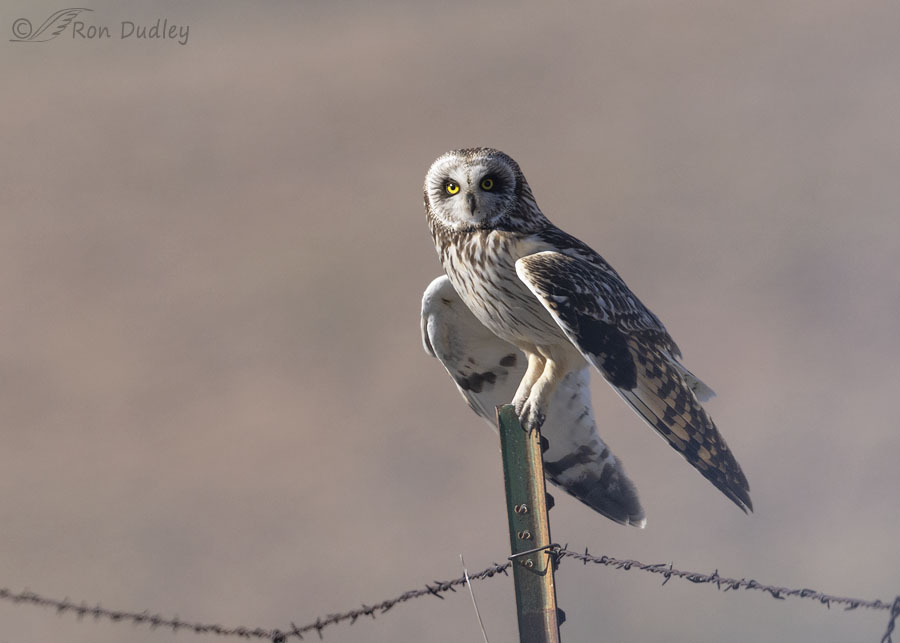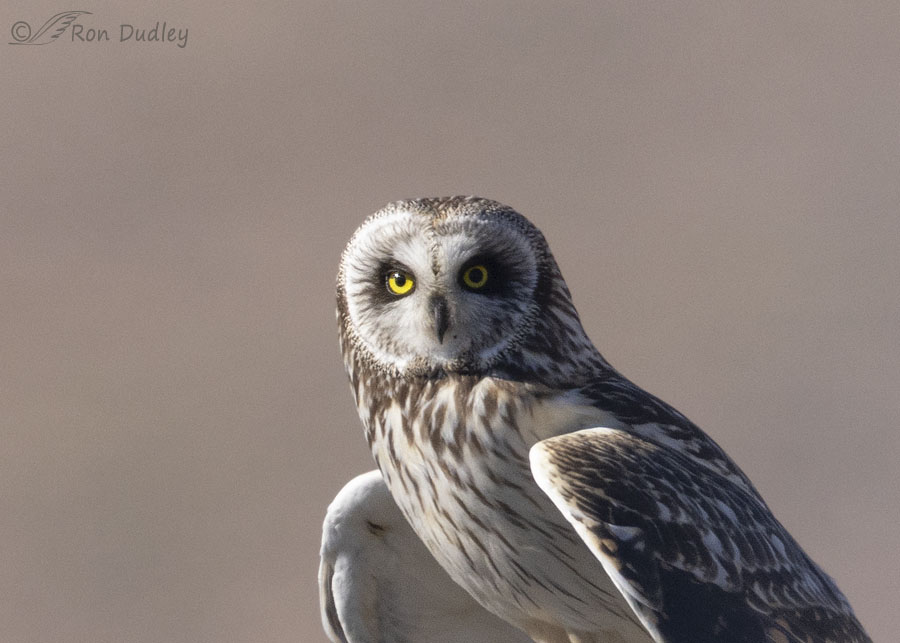And a little mystery involving the physics of light.
I haven’t had many chances with Short-eared Owls in recent years but three days ago I had a lot of fun with two of them. I plan on posting more photos of them after my upcoming medical adventure so this one is only a teaser.

1/4000, f/6.3, ISO 500, Canon R5, Canon EF500mm f/4L IS II USM + 1.4 tc, not baited, set up or called in
I think both owls had as much fun toying with me as I had trying to photograph them because they insisted on posing only in sidelight or backlight, no matter where they perched while they were hunting and even though they had other options. This owl held this somewhat unusual wings-down pose for the entire time ‘he’ was on this fence post and I’m not sure why. He always held his wings in a more normal position while he was perched elsewhere.
Does anything in this photo look a little “off” to you? Something does to me.
The top of his eye is in deep shade so why is the catch light in that portion of his eye?

At first I thought, well maybe I caught him blinking with his nictitating membrane and the catch light is a reflection off of the wet membrane but I don’t think that’s the case. When I crop in even more tightly than this I’m pretty sure it’s a shadow cast by his deeply-set eye in its orbit or possibly by his upper eyelid.
And besides, I took four photos of him in a row and in each of them the shadow’s in the same position. It would be highly unlikely for him to hold his membrane in this position for that long. Additionally, the membrane of this species doesn’t come down from the top of the eye. It originates in the inside corner of the eye and closes pretty close to horizontally across the eye.
Seems to me that on sunny days catch lights would only be reflected off of the portion of the cornea in direct sunlight. And I believe I’ve seen this phenomenon before in Short-eared Owls so that only heightens my curiosity.
No biggie but when I see funky stuff like this in my photos I tend to focus on it until I figure it out. If I ever do.
Ron
Note: Phil Hodge may have solved the mystery. See his comment below.


Have to say that the eye looks “normal” to me, but then I see a lot of owl eyes. The clear cornea is a full hemisphere in front of the flat iris. When seen from the side, the cornea looks like half of a crystal marble plopped in front of the flat plane of the iris. And yes, owls can blink their nictatating membranes independently. Right now, I’m caring for 5 orphaned Great Horned Owl chicks being raised by the unreleasable Great Horned foster dad who lives here permanently. All twelve eyes watch my every move when I bring food in the late evening. Best wishes Ron, on your surgical adventure!
See, I’m gonna let all the science-biology-physiology-oriented folk here focus on the eye thing because I have no clue (I was an English/history major, after all) — instead, I’ll spend my time focused on the incredibly beautiful creature you’ve captured here with the “hang-down” wing which adds to its mystery. And thank you for the closeup so I can drink in more of that lovely face!
PS — Happy World Environment Day to one of my favorite (even if accidental) environmentalists!
Thanks Chris, whether I’m “accidental” or not is up for debate but I’m definitely died in the wool…
As soon as I saw the title of your post I knew I was in for a treat. A big treat.
Huge thanks to you and to your knowledgeable commentators.
Thank you, EC.
I think Phil’s explanation is right. The front portion of an owl’s eye is tubular and projects far forward. Unfortunately, I think the quote Ed found is somewhat misleading. The eyes are indeed large but that’s not just the result of the tubular front portion. The whole eye is very large. A Great Horned Owl has eye only slightly smaller that ours, which is huge for its body size. The larger eye can allow more light on a large retinal surface assisting with night vision. There really is no room for large muscles to move the eye. The bony plates (sclerotic ring) that helps[ hold the eye in place is a structure found in all birds (and reptiles), not just owls, although these plates are larger and less flattened in owls than most other birds. Muscles pulling against these plates can also help change the shape of the eye to quickly accommodate from near to far vision but this is less effective in owls. A cormorant can change the eye to see to within a few millimeters of the front of the eye. An owl cannot focus that close and must back away.
“An owl cannot focus that close and must back away”
Then owls must feel like I do when I’m closer to my photo subject than the minimum focusing distance of my lens!
Thanks for all that interesting info, Dan.
Phil’s explanation makes sense to me, though I’m still puzzled by the dark cornea. If shade is the cause of the partially dark cornea, then why is the the cornea in the left eye not totally dark? Nictitating membrane abnormality? Abnormal pigmentation?
Good question Lyle and I’m not sure about the answer. But at this point at least I still lean toward Phil’s explanation, for what that’s worth.
This is a neat observation and I am impressed at how you caught this interesting effect, Ron. I think Phill is correct, the owl’s eyes are like tubes versus a sphere, they stick way out front. The front part is illuminated by the sun ray and hence the glint.
Here is a quote from a reference: “An owl’s eyes are large in order to improve their efficiency, especially under low light conditions. In fact, the eyes are so well developed, that they are not eye balls as such, but elongated tubes. They are held in place by bony structures in the skull called Sclerotic rings. For this reason, an owl cannot “roll” or move its eyes – that is, it can only look straight ahead!”
From https://www.owlpages.com/owls/articles.php?a=5
Can the nictating membrane be activated on one eye independent of the other?
“Can the nictating membrane be activated on one eye independent of the other?”
I believe they can, Ed. I’m pretty sure I have photos showing one membrane at least partially closed and the other one fully open.
I think the “wings down” posture takes wonderful advantage of the raking
angle of the light– and whatever has caused the top wire of the fence to
catch downward, then return upward, adds a surprisingly dynamic
element to the beautifully quiescent owl……..a real visual treat– thanks !
Kris, the top wire is pulled down by a vertical wire attached to the top wire and a lower wire on the fence.
Interesting! Both the wing position and the catch light tho Phil seems to have a logical explanation for the latter. The balance thing that someone else mentioned may be at play. Regardless, a wonderful shot!
The balance thing that someone else mentioned may be at play. Regardless, a wonderful shot! 
Yep, procedure time slipping up on you – a good news/bad news things (having to have it done).
A Robin has been added to the circus of the Magpies and Grackle – doesn’t care for either of them tho seems more concerned about the Grackle than the Magpies…….
Sounds like there’s a lot of excitement on your property, Judy. About the only avian excitement I’ve seen in my yard recently is battling female Black-chinned Hummingbirds.
You are getting blase there. Hummingbirds (battling or not) would cause HUGE excitement here.
Kinda like having kangaroos in my back yard…
Nice shot. I think it has to do with the deeply set eye orbit, but I am certainly no expert on Short-eared Owls – I have only seen them in your posts.
Thanks, Everett.
Lovely photo. Short eared owls are a favorite of mine, but are not something I’ve gotten to observe nearly often enough. Thanks for this “extra” view.
I’ve seen a number of birds do this their wings. Usually they were water birds, and it may have helped dry them. Doesn’t seem like a reasonable explanation for this apparently dry owl.
Nope, he wasn’t wet Nancy. Some birds hold their wings like that when it’s hot but it was a coolish morning, probably in the mid 50’s when this photo was taken.
Is it possible the shadow on the upper part of the eye is from his eyelashes? If so, the bright sun may be shining right through.
Porcupine, if the shadow was caused by his upper eyelid, a possibility I mentioned, his “eyelashes” may have contributed to it.
I think we can see the catch light in front of the shadow because the shadow is on the iris, and the cornea is a significant distance in front of the iris.
That makes sense, Phil. And maybe the tubular shape of the eyes of owls contributes to the effect. I’ll make a note of it as an addendum to my post.
That may solve the mystery, which would satisfy my curiosity, but a catch light that appears to be in the shaded portion of the eye still looks funky to me…